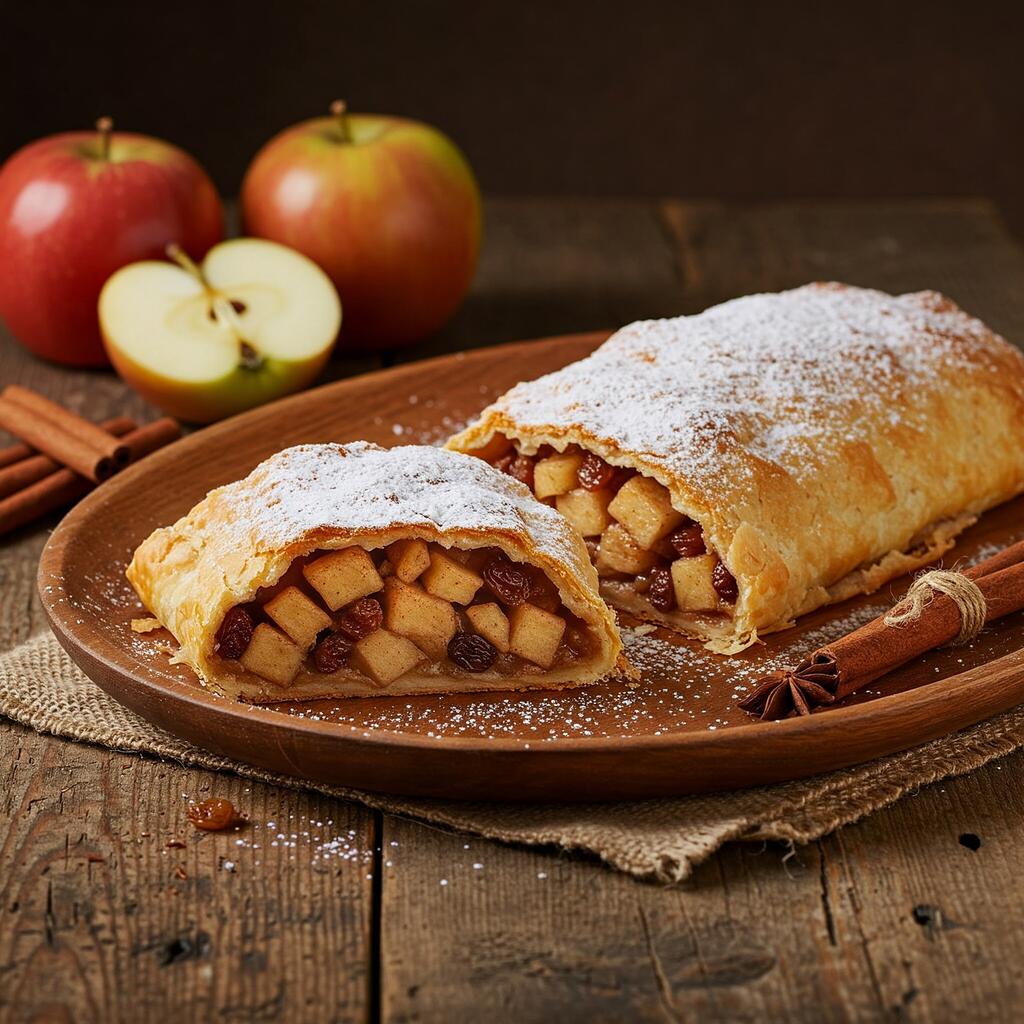
Traditional Flavors of the Apple Strudel Recipe
Apple strudel, or Apfelstrudel in German, is not just a dessert: it's a taste of history, culture and flavors that derive their roots in Central Europe.
Picture entering a Viennese coffeehouse with a view of the Ringstrasse, velvet armchairs and crystal chandeliers, the scent of melted butter wafting through the air: that's where strudel is meant to be, as it becomes the symbol of Austrian hospitality.
Each layer of its delicate crust holds centuries of gastronomic interactions that from the Middle East to the Ottoman Empire influenced the Habsburg courts and resulted in the birth of a dessert now immortal.
It is reported that the pastry cooks used to compete to produce the thinnest crust: the judge had a shroud of dough pulled back in front of a window and, if light could pass through the surface unobstructed, the trial was passed.
This custom has shaped the modern technique, still transmitted these days in Viennese pastry schools and Tyrolean, Salzburg family kitchens and even over the border, where there are numerous regional variations reflecting the local personality of one great recipe.
For those who want to try to make their own dough, all you need is some simple ingredients and a little patience: sifted 00 flour, one egg to give it some structure, a small amount of extra virgin olive oil or melted butter to get the right amount of elasticity, lukewarm water to keep the dough together and a touch of salt to give it balance.
Some masters add a splash of vinegar, or lemon juice, a trick that loosens the gluten and softens the dough. After the ten minutes of fierce kneading are past, the dough ball is left to rest in a warm spot under a damp cloth: while it rests, the protein chains unwind, preparing for the legendary "transparency test".
The filling is seasonal in homage: tart apple such as Granny Smith or Braeburn, sliced very thinly so that they can cook evenly, are combined with caster sugar, cinnamon and lemon juice.
Raisins are rehydrated by the majority of pastry chefs by soaking them in rum or grappa first and then adding them to the mixture; this brings out the fragrances and adds a velvety texture.
For added texture crunch, some toast the breadcrumbs in clarified butter, topping them with a dash of brown sugar that lightly caramelizes in the oven, imbuing them with a hint of hazelnut.
The pièce de résistance is when the dough is rolled out onto a large floured tablecloth, spreading the knuckles out from the center. The muffled sound of the dough becoming thinner is reminiscent of the cackle of a Danube mill along the Danube, and the top becomes so thin that you could read a newspaper underneath it.
The filling is spread along the short edge, with space at the ends to prevent spilling out. This is where the rolling ceremony takes place, a sleek glide that enwraps the fruit and spice in an unblemished whirlpool – the strudel actually gets its name from "whirlpool".
The top is liberally brushed with melted butter before baking, not just creating a glistening crust on the pastry, but little channels for steam to make its escape between the layers as well, creating the crumbliness of the strudel.
Bake in a static oven at 190°C for about forty minutes, putting the baking tray in the bottom third of the oven to help with even browning. The aroma that fills the kitchen during baking is an hug of sweet apples, cinnamon and creamy undertones: an aroma that transports one back to childhood reminiscences even in those not born in the Alps.
Serving strudel is an art form: it is allowed to rest for at least ten minutes to settle the filling, then it is cut using a serrated knife not to break the pastry. Icing sugar sieved over an extremely fine sieve sprinkled on the top transforms the dessert into a complex miniature snow scene.
It is typically served in Austria with Schlagobers – whipped cream that is not sweetened – or a silky vanilla cream, but it is excellent with a scoop of cinnamon ice cream or a glass of Riesling Spätlese, whose balance of freshness and sweetness brings out the fruitiness.
The creative types may experiment with seasonal variations without straying from the recipe proper: in summer, the addition of sour cherries adds splash of color and tart contrast, and in autumn, a combination of dried cranberries adds woody undertones.
If you like crunch, throw some toasted hazelnuts or a handful of pecans into the breadcrumbs; if you want an exotic flavor, try to add some heat to the filling with some cardamom grains or some fresh ginger grated over it.
For a modern variation, the strudel vegan replaces butter with vegetable margarine or deodorised coconut oil and does not contain egg in the dough by introducing additional warm water.
Even those with gluten dietary requirements can enjoy an excellent strudel by using natural grains such as very finely ground rice and corn flour and binding them together by using a mixture of xanthan gum and psyllium seeds to get the same amount of elasticity as regular dough.
For the lover of shortcuts, there is another way using pre-made puff pastry: it won't achieve the translucency of "pulled" dough, but it will give a light, airy crust. Simply roll out the pastry, fill it to tradition and bake at 180°C until the edges break up into a thousand golden layers.
It's a solution to last-minute dessert emergencies at the cost of the poetry of apple and cinnamon filling. Apple strudel is not only the "perfect dessert" to serve at Christmas, but can also be prepared in advance and will recover its crispiness if reheated in a fan oven at 160°C for a few minutes.
Leftovers can be stored for two days under a glass dome in a dry, cool room. Others even have it for breakfast, warmed very gently and with a robust espresso or a very frothy cappuccino.
Nutritionally, strudel is an interesting mix: apples add fibre and pectin, and cinnamon some antioxidant effect. There's sugar, of course, but the possibility to reduce it or replace it in part with low-glycaemic sweeteners makes this pudding adaptable to many needs.
Low-calorie dieters may omit the butter employed to glaze the top and use plant milk or water and sugar, which also yields a light delicate golden glaze. Apple strudel is finally about cooking as communal memory: every slice of strudel becomes part of family history, every speck of icing sugar bringing back visions of white landscapes in Austria in winter.
Making it requires entwining a fine thread between the past and the present, between grandmothers kneading dough to the rhythm of a waltz and young chefs reinterpreting tradition with modern techniques.
And when, biting into it, the first crunch of golden pastry breaks the hush, you know that so great is the sensual pleasure the drudgery of rolling out the dough: for real apple strudel is fundamentally an act of love for those with whom you shall be sharing it.












